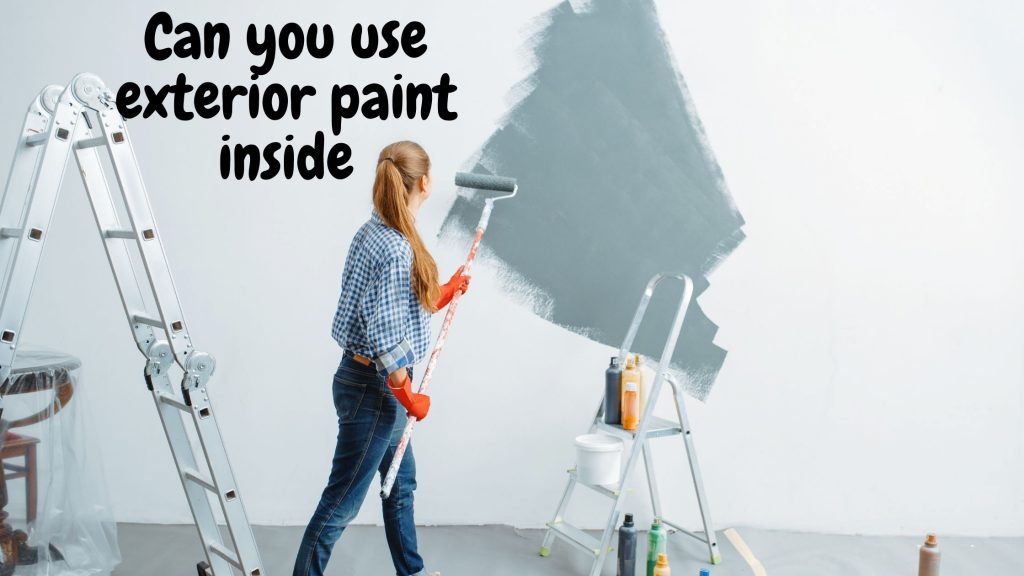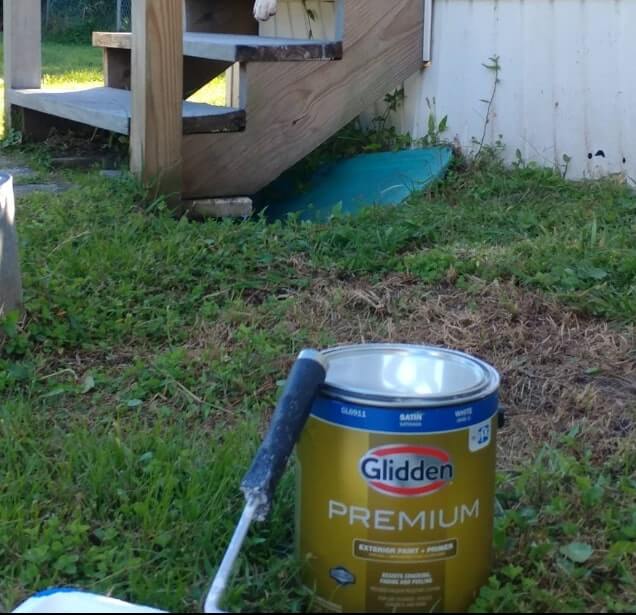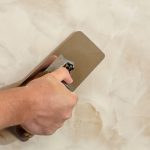Have you recently done an outdoor painting job and ended up with half-filled paint tins leftover? Now you’re not quite sure what to do with them because the paint is exterior paint. An accent wall in the study or covering up your kid’s scribbling masterpieces in the living room is a convenient solution to not wasting it. But then you’re left with the question- can you use exterior paint inside?
Technically, yes, you can use exterior paint inside. However, there is a good reason why you shouldn’t. Exterior paint additives give it its protective characteristic but at the expense of your health. The volatile organic compounds (VOCs) in this type of paint are a health hazard. So, it is not recommended to use exterior paint inside.

Well, today, we will learn in detail all of the properties of exterior paint, what and why it is used, and if we can (should) use exterior paint inside or not.
Navigation
What Is Exterior Paint?
The term is self-explanatory- exterior paint- paint that is used for external surfaces. Generally, all different types of paint will have the same basic components.
Then, depending on the paint usage, there will be some additives to make it serve a particular purpose.
In general, any paint has 4 basic components- pigment, binder, solvent, and additive. In addition to the basic compounds that form paint, exterior paint will have some special elements.
Silica, zinc oxide, 100% acrylic binders, and inorganic colorants are the most common substances used to make exterior paint.
Exterior paint is generally applied on any surface that is exposed to the outdoors. For example, the outer walls, windows, and doors of buildings/ houses. Its main function is to protect the external surface.
Continuous and long-term exposure to sunlight, rain, snow, mold/ fungus build-up, mildew, and even the wind can cause severe damage.
Can you use exterior paint inside-Is It Dangerous?
We have already learned that all categories of paint have the same basic compounds and they give paint different properties. These specific components protect the outside surface but can be quite harmful when used for interior walls.
While it might seem convenient not to waste that leftover paint on one of the inside walls, you’re better off throwing it away.
Some additives in exterior paint, such as acrylic latex and enamel or oil-base, will produce VOC (volatile organic compounds). VOCs such as ammonia, benzene, formaldehyde, toluene, xylene etc. are notoriously carcinogenic.
VOCs also emit an unpleasant odor and have potentially hazardous side effects in long-term exposure. Some side effects are dizziness, nausea, breathing difficulties, and irritation of the eyes, nose, and throat.
If you want to put leftover exterior paint to good use, then you can paint the balcony walls or slab it on patio furniture. These surfaces are more likely to stay outdoors or in a well-ventilated space so they will have a lower risk of side effects.
However, it is best to avoid using exterior paint indoors, even if it’s just a small accent wall, as a rule of thumb.
What happens if you accidentally use exterior paint indoors?
If you have accidentally used exterior paint inside, there is no need to panic. You don’t immediately start vomiting or having a fit when you walk into that room.
However, you will find a weird smell in the room, which can be unsettling. Once the surface has properly dried up and there is sufficient ventilation, there is nothing to worry about.
If you still feel uncomfortable, you can always repaint with interior paint. But, because of the different compounds in interior paint, it won’t sit on the surface of exterior paint.
You should remove it properly before applying your desired paint. We’ll get into the details of this process later.
So just relax; you won’t need to get in a frenzy if you later discover that you’ve applied exterior paint inside your house. You should be fine if it’s a room with good air circulation or just a less frequently visited room.
Though it is always a good idea to double-check the properties and chemical composition of paint before you buy/ apply it.
How to remove exterior paint from interior walls?
We’ve already discussed a solution to painting your walls with exterior paint earlier- repaint with interior paint!
You may have found yourself in a room that has a really old wall with paint chipping and flaking off, or the smell of paint is giving you a headache.
Or, maybe you are just not happy with the ugly color! Regardless of how exterior paint ends up on your walls, you can easily take it off and brush it over with your favorite color.
Here are a few simple steps to taking off exterior paint from interior walls:
Step 1– Prepare the room. Try to move as much furniture out of the room. Anything that you can’t or don’t want to move, cover it with a large discarded cloth. Clean the walls, and wipe away any excess dirt or other debris.
Step 2– Using a paint scraping tool (electric or manual), slowly start to scrape away any loose paint from the wall.
Step 3– Apply caustic soap on the painted wall using a mop and leave to dry. (Be extra cautious with this as it is quite toxic. Use protective gloves and a mask.).
Step 4– Once completely dried, the paint should be very easy to scrape off using the scraper.
Step 5– When you’ve removed all of the paint, clean the walls properly with some sugar soap solution.
Step 6– Prime your walls with odor control primer before applying paint.
Step 7– Apply as many coats of your favorite paint as you need. Let it dry and voila! You have a new wall!
Can you use weathershield paint indoors?
Weathershield paint is specially designed for external use. This type of paint is typically chosen for its exceptional durability in extreme weather conditions. They also have the ability to protect from fungus, algae, mildew, and other surface growth on building surfaces.
As its name indicates, it is designed to shield the surface from the continuous effects of weather. Hence, it is intended to be used on exterior surfaces and not interior surfaces.
Moreover, the components that give weathershield paint its protective characteristics are quite harmful. External paint has VOCs, which emit toxic fumes that can become a health hazard over a long period of exposure.
If you are thinking about using weathershield paint indoors for their glossy sheen look, then you should explore a bit more.
Plenty of polished, semi-glossy, or satin finishes are available in interior paint. It’s better to stick to using interior paint for indoor surfaces.
Can I use exterior paint inside my bathroom?
Bathrooms can be tricky to paint. Exterior paint might seem ideal paint. It has anti molding, water-resistant, and mildew resistant properties. So this must be perfect for the bathroom, right?
However, the chemicals in exterior paint, such as acrylic resins, are responsible for VOC. So, exterior paint shouldn’t be your first choice when painting your bathroom.
Bathrooms are continuously exposed to high moisture content, dampness, and water being splashed on the walls. You want to keep this room at the highest peak of cleanliness because this is where personal hygiene upkeep happens.
Just as there is specific paint for the outside walls, inside walls, and furniture, you can also get paint meant to be used inside bathrooms.
Paint with a glossy, semi-glossy or satin finish is perfect for bathrooms. Compared to regular indoor paint, paint designed for bathrooms will contain a different resin type.
They are better at holding the paint together. Bathroom paint can provide more robust protection from moisture, mildew, chipping and peeling off.
So next time you’re off paint shopping for your bathroom makeover, you’ll know what to look for in the composition list.
Can you use exterior paint inside my garage?
Surely you can paint your garage with exterior paint. But ask yourself first if it is safe to use exterior paint on the walls.
You could think that because your garage is not actually inside the house, you should be applying exterior paint. However, it is still a closed space, only opening up to let the car come in or leave if you think about it.
From what we’ve learned so far, exterior paint is not at all a good idea or even intended to be painted on indoor surfaces.
A garage should be no exception. Even if you technically can paint the garage wall with exterior paint, you definitely should not.
Can exterior latex paint be used inside?
Yes! Absolutely! In fact, it is probably the best choice for painting interior surfaces. Let’s learn why.
Latex paint is a water-based paint that is made with acrylic resins. Because it is water-based, it has fewer chemicals than acrylic paint. Thus, latex paint will produce less odor and is considerably less toxic than acrylic.
Latex paint will dry much faster and because it is water-based, it’s super easy to clean with just soap and water.
Though don’t be fooled by its simplicity. Latex paint will still give you the same protection from mold, fungus, and mildew and it is also water-resistant. You can even find a wide variety of finishes.
Can you use Sherwin-Williams exterior paint inside?
Not quite. There is a good reason why Sherwin-Williams have different types of paint categories. They have been designed to serve different purposes and conditions.
Being in the business since 1866, Sherwin-Williams is a pioneer in the painting industry. They have mastered paint making with constant innovation and new technology.
They have designed their paints to be versatile and multifunctional. Even their exterior paints produce fewer VOCs and are less toxic. Which may lead some people to interpret as safe to be used for indoor surfaces.
However the truth is, the brand doesn’t even market its exterior paint to be safe to use indoors.
So don’t let brand quality temptation lead you to put your family’s health at risk. Because they’re not making any recommendation for you to use exterior paint inside your home.
Can you use Glidden exterior paint inside?
Yes, among many brands, Glidden’s exterior paint is one of those rare paints that you can use inside your home. Sounds a bit contradictory to everything you’ve just read in this article? Well, you’re about to find out why!
We’ve repeatedly mentioned that exterior paint is not a good choice for interior surfaces. The same rule does apply to Glidden’s exterior paints.

However, something is fascinating about Glidden. Glidden has a premium product that is suitable for both exterior and interior surfaces. They have formulated this product to have low VOCs and less odor.
It is designed to resist cracking and peeling and with its glossy finish, the color will surely not fade away. Glidden’s Premium Interior/Exterior paint is a perfect choice.
Summery (The Ultimate recommendation)
Take into account all of the points we’ve discussed in this article. Of course, you are free to make your own decision.
However, I’m sure by now you have understood the fundamental differences between exterior and interior paint. Even though you might want to use up the leftover paint lying around, do think about where you will apply it.
Maybe you can put it to good use by painting your dog house’s front door or roof. Better yet, see if any of your friends need a new look for their garden fence.
So you technically can paint your interior walls with exterior paint but the major aspect to consider is if you should. Do you really want to intentionally put paint inside the house that’ll leave a pungent smell?
Have paint that has VOCs and is not necessarily serving its purpose by being inside? Well, I don’t think so.
I hope the information you’ve gathered from here will help you make a sound decision on whether you should use exterior paint on your interior walls.




